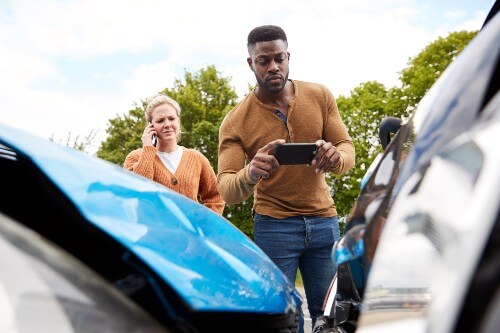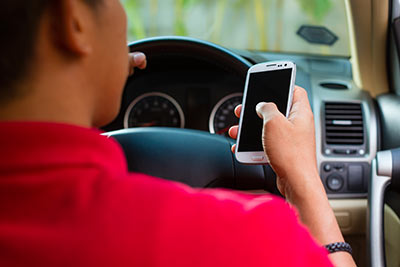When it comes to car accidents, Nevada is what we call an “at-fault” state. This means that the party who causes the accident–or in most cases, their insurance company–is legally responsible for paying any damages sustained by the victims. But ascertaining fault is not always so simple. In a two-car accident, both drivers may try and point the finger at each other. So how are such disputes resolved?
How Is Fault Determined in a Car Accident?
The initial determination of fault is usually left to the insurance companies. Anytime you are injured or suffer property damage in a car accident, you should always file a claim with your own insurance company. If you believe another driver was at-fault, you also should file a claim with their insurer.
The insurance companies have adjusters who investigate car accidents. The adjuster will look at many different types of evidence. First and foremost, they will look at any statements that you or other driver have made regarding the accident. If there were any passengers in the vehicles or other eyewitnesses, the adjuster will want to look at their statements if available.
Other types of evidence that an insurance adjuster may look at include, but are not limited to:
An official police accident report;
- Photographs of the damaged vehicles and/or the scene of the accident;
- Any video surveillance footage of the scene;
- Repair estimates and other reports prepared by any mechanics who worked on the damaged vehicles;
- Weather reports from the day and time of the accident; and
- In unusually complex cases, there may also be reports prepared by trained accident reconstruction experts.
One thing to note about police accident reports: They are not admissible in court and do not, in and of themselves, proof that a driver was legally at-fault for an accident. From a legal standpoint, a police report is basically a form of “hearsay,” i.e., it reports things that the officer did not personally witness.
That said, it is still always a good idea to call 911 and ask for a police officer to come to the scene of a car accident. A police report can provide useful factual information–such as the exact time of an accident or the names of any witnesses–that may prove useful to yourself or the insurance companies involved.
Another thing to keep in mind: While insurance adjusters may conduct the initial investigation into an accident, that does not mean you have to talk to an adjuster representing the other driver’s insurance company. In fact, it is usually not in your best interest to do so. If the adjuster believes their driver was at-fault, they may try and lowball a settlement offer to try and escape full responsibility for the accident. This is why you should never talk to an insurance adjuster without the advice of an experienced Las Vegas car accident attorney.
Negligence and Car Accidents
When a driver is legally at-fault for a car accident, they are negligent. Negligence is not the same thing as criminal liability. Indeed, many car accidents are just that–accidents. Nobody intended to cause a wreck. Yet through reckless or careless behavior, one happened.
- Negligence requires proof of all of the following:
- The driver owed you a duty of care, e.g., to drive their car in a reasonably safe manner that complies with Nevada law;
- The driver breached that duty through a negligent or reckless act; and
- As a result of that breach, you suffered some injury, including damage to your car.
Negligence can take many forms. Perhaps the most common is a simple failure to obey traffic laws. If a driver runs a red light and strikes another vehicle that is lawfully in the intersection, the first driver is negligent in causing the accident.
When a Driver Is Distracted
Distracted driving is also often a substantial factor in causing car accidents. In recent years, state officials have tried to crack down on some of the more common causes of distracted driving. Nevada is one of many states that currently ban texting while driving. Actually, in Nevada it is against the law to manually operate a smartphone while operating a vehicle. This includes not only using your phone to text, but also accessing a web browser or using any other app while driving. When a driver was obviously not paying attention and there is some evidence to attest to this, that may be sufficient proof of that driver’s negligence. It is essentially a breach of that person’s legal duty to drive safely and keep their eyes on the road.
Accidents Due to Drunk Driving
Drunk driving, is obviously illegal. A person can face serious jail time for a DUI, especially when it causes a car accident. Aside from criminal liability, the victims can also cite drunk driving as proof of the driver’s negligence in a personal injury lawsuit.
It is important to understand that civil and criminal cases follow different standards of proof. In a criminal DUI case, a Nevada prosecutor must prove the defendant’s guilt “beyond a reasonable doubt.” In a personal injury lawsuit brought by an accident victim, however, proof of negligence can be established through a “preponderance of the evidence.” This is a lower standard. More to the point, when someone causes a wreck due to intoxication, even if they are acquitted or never charged with a crime, they can still be held liable in civil court.
Were you hit by a drunk driver in Las Vegas? Speak with an experienced Las Vegas drunk driver accident lawyer for legal guidance.
What Happens If I’m at Fault in a Car Accident?
As mentioned earlier, it is not uncommon for two drivers in an accident to try and point the figure at the other. This can extend to the trial of a personal injury lawsuit. A defendant may try and escape liability by claiming the plaintiff was partly or totally at-fault themselves for causing the accident.
Even if that is true–i.e., you were partly to blame for what happened–that does not necessarily mean the other driver is off the hook. Nevada follows a “modified comparative fault” rule in personal injury cases. This is a fancy way of saying that when more than one person may be responsible for an accident, the jury (or judge) will apportion fault as a percentage among all of them. The defendant is then only held responsible for their relative share of the damages.
The “modified” rule means that the plaintiff can only recover damages if their own comparative fault was not greater than the combined fault of the other parties. In plain English, if you sue another driver for causing an accident, you walk away with nothing if the jury decides you were 51 percent or more at-fault. But let’s say the jury comes back and says you were 49 percent at-fault. The other driver still has to pay 51 percent of your total damages arising from the accident.
How to Prove You Are Not at Fault in a Car Accident
The best way to prevent the other driving from holding you at-fault is to not give them any evidence to use against you. For instance, in the moments following an accident, do not apologize or admit fault to the other driver. Even if you just made such statements out of panic, they could still be used against you later.
Next, document as much evidence from the accident scene as possible. Take pictures with your smartphone. If there are impartial witnesses, take down their contact information. And as previously discussed, call 911 and get an officer to come down and prepare a formal accident report. All of this evidence can not only help prove the other driver was at-fault–it can also exonerate you if the other driver tries to blame you.
And of course, you should speak with a qualified Las Vegas accident attorney who can advise you of your legal rights and protect your interests. Contact the top-rated Las Vegas injury attorneys at Ladah Injjury & Car Accident Lawyers Las Vegas today to schedule an initial consultation 702-252-0055.

